Note: This website was automatically translated, so some terms or nuances may not be completely accurate.
Let's go!
This series follows Dentsu Inc.'s 'Company Design' team as they uncover the secrets behind vibrant companies with 'originality.' In the 20th installment, we explore corporate transformation insights from Minami Holdings' challenge to revolutionize the business model of a driving school that has operated for over 60 years.
What image comes to mind when you hear "driving school"? It feels less like a traditional "school" like elementary, middle, or high school, and more like a "skills training center." Or perhaps it evokes the feeling of being forced to attend morning radio calisthenics during summer vacation. It wasn't about "going to learn" something or "deepening connections" with others; it was more like just going to collect stamps.
Considering the times, it's a rather serious industry. Young people are increasingly turning away from cars. The number of young people themselves is declining. Cars aren't selling well either. Add to that the COVID-19 pandemic. It's hard to even feel that sense of excitement about getting a license and inviting friends for a drive. If AI-powered autonomous driving becomes widespread in the near future, getting a license might not even be necessary anymore.
Amidst this, there's a person in Fukuoka who took over a driving school with over 60 years of history from the previous owner at age 30 and has been rolling out one surprising initiative after another, stunning the world. This is fascinating.
Earlier, I compared it to "being forced to attend radio calisthenics during summer vacation." The key point isn't the calisthenics themselves, but the "being forced" part. Driving schools are often seen as a necessary, grudging step toward getting a license. I posed various questions to President Yoshiro Egami, who has taken a radical approach to transform this very institution.
Written by: Makoto Kunio (Dentsu Kyushu Inc.)

Founded February 1956. A designated driving school located in Onojo City, Fukuoka Prefecture. With the corporate philosophy of "Creating People Full of Sensibility," it aims to foster "people who cultivate sensibility" – a unique goal achievable in a driving school setting where the fundamentals of safe driving are learned. It has pioneered numerous initiatives, including the introduction of an online theory system and learning app using the animated theory textbook "DON!DON! Drive," the advanced accident prevention theory "KM Theory," and ensuring all instructors hold the "Master of Praise Certification." It serves as the parent company of Minami Holdings.
What exactly is a driving school?
At the start of the interview, I shared my candid view of "driving schools" with President Egami. His response was this: "You're absolutely right. When I took over the company from my father 11 years ago at age 30, that was exactly how it felt. Both the instructors and the students seemed kind of gloomy. It's a very simple idea, but the starting point for our reforms was: Can't we make this a brighter, more enjoyable school?"
There are currently about 1,200 driving schools nationwide. However, that number continues to decline year after year. Minami Fukuoka Driving School is number one in Kyushu. Even so, it was obvious that if we didn't take action, our revenue would keep falling. "First, I asked myself, 'What is a school, fundamentally?' Above all, it's a place to learn skills and knowledge, right? Think back to your student days. When you were trying to master something, didn't it sink in easily to your mind and body when you found enjoyment in it? In other words, schools, education, and entertainment are highly compatible."
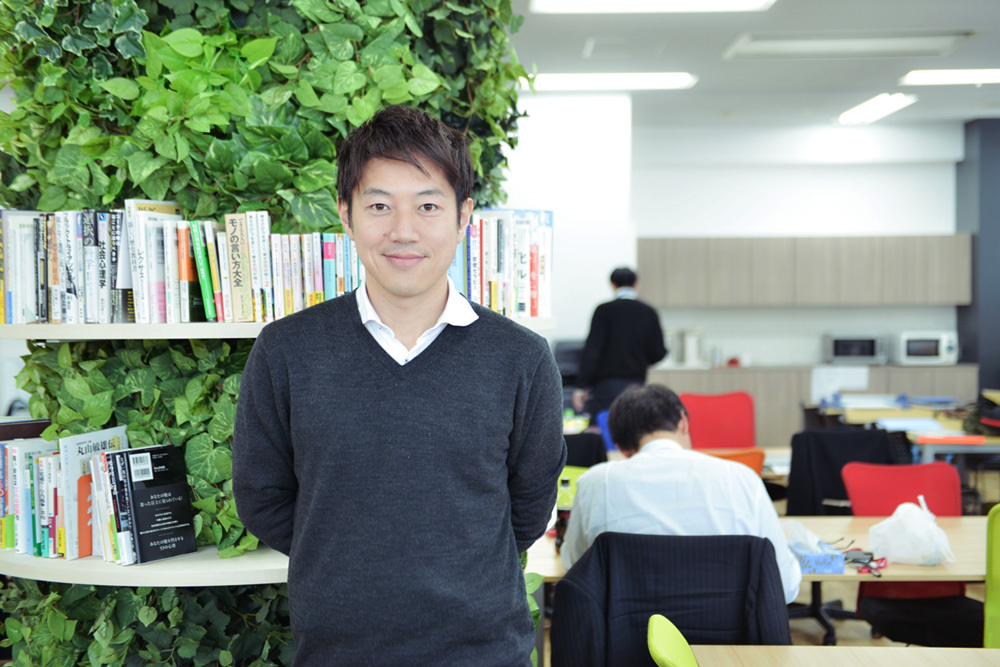
Born in Fukuoka Prefecture in 1981. Graduated from the Faculty of Science and Technology at Tokyo University of Science. After graduating, joined Nexway (formerly Recruit FNX Dⅳ. Inc.), part of the Recruit Group, where he was involved in new business planning and recruitment, receiving over 15 awards. After serving as a director at an internet venture, he joined Minami Fukuoka Driving School in 2010 and became its President and CEO the following year. He implemented painful reforms, achieving a V-shaped recovery in performance within a declining industry. He also lectures nationwide as "Kame Rider," a traffic safety hero in a full-body suit. Currently, he advances business as President and CEO of Minami Holdings, overseeing Minami Fukuoka Driving School and related companies like "Driving School Support."
President Egami emphasizes another crucial point: communication between instructors and students, and among students themselves. "Think back to your student days. Remember the teachers whose classes were memorable? They were fun, right? You enjoyed interacting with classmates and club members, making you look forward to going to school every day. So why is driving school so gloomy? Honestly, I wanted to shake off that gloom."
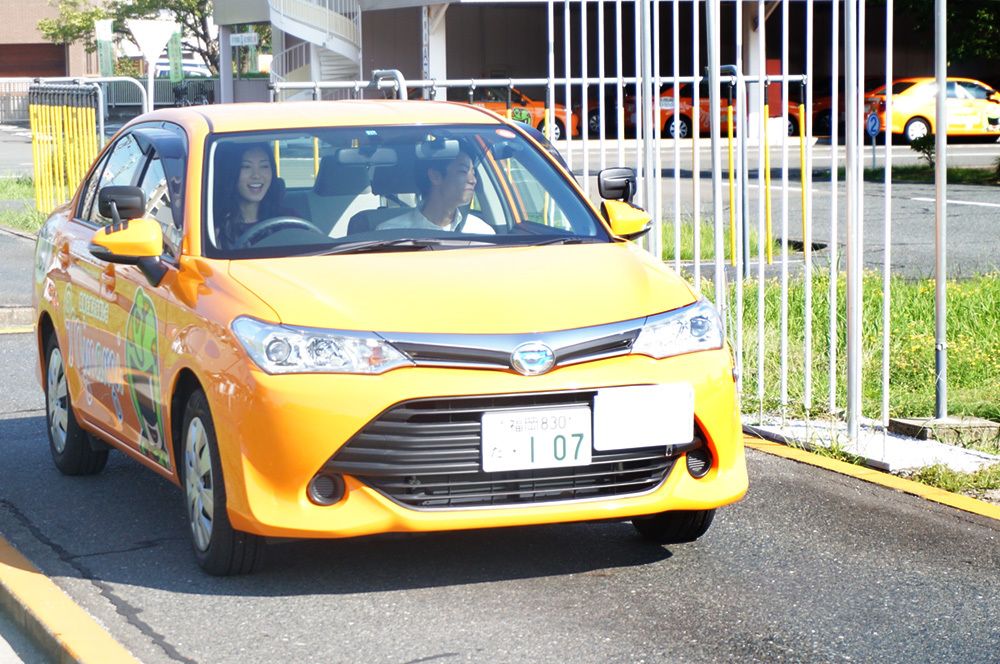
Breaking free from a downward spiral is no easy task
President Egami states that the most serious issue in the driving school industry is the shortage of instructors. "The declining student numbers due to the shrinking population and aging society are often reported, but the truly critical problem is the rapidly decreasing number of instructors. Even when prospective students come to enroll, we have to turn them away because we don't have enough instructors to handle them. This isn't just our company; it's a nationwide issue."
President Egami says escaping this downward spiral is no easy feat. So, we advertising agencies can't help but suggest campaigns like this or events like that. "The crucial thing isn't fireworks-like gimmicks, but reforming your own organization first. Above all, you need instructors to think, 'I like this company. ' ' ' ' ' ' ' ' ' ' ' ' ' ' ' ' ' ' ' ' ' ' ' ' ' ' ' ' ' ' ' ' ' ' ' ' ' ' ' ' ' ' ' ' ' ' ' ' ' ' ' ' ' ' ' ' ' ' ' ' ' ' ' ' ' ' ' ' ' ' ' ' ' ' ' ' ' ' ' ' ' ' ' ' ' ' ' ' ' ' ' ' ' ' ' ' ' ' ' ' ' ' ' ' ' ' ' ' ' ' ' ' ' ' ' ' ' ' ' ' ' ' ' ' ' ' ' ' ' ' ' ' ' ' ' ' ' '
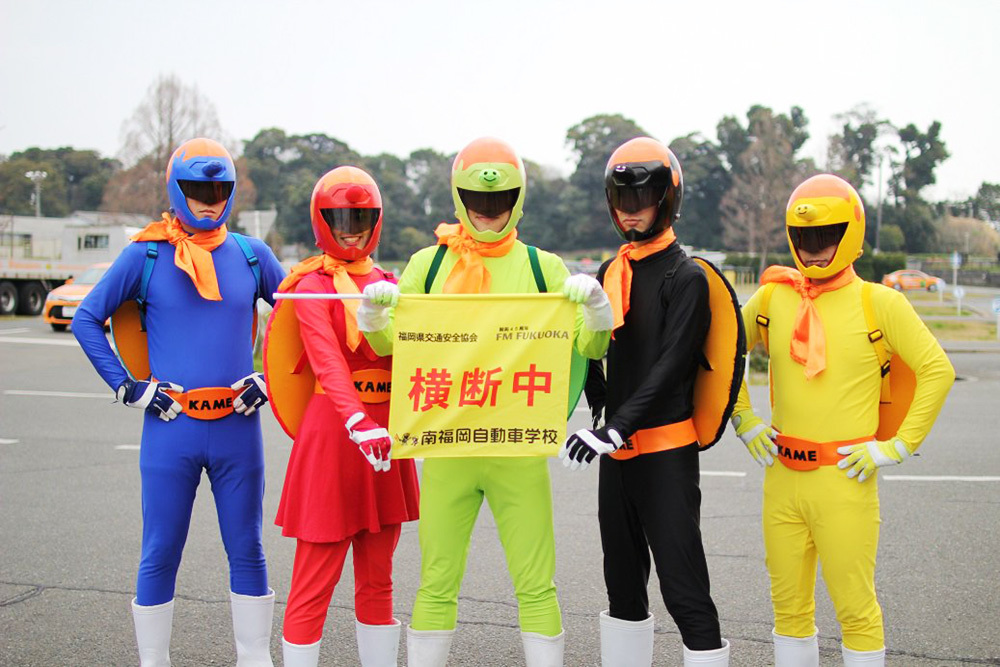
The mascot character for Minami Fukuoka Driving School. As a traffic safety hero, he participates in bicycle safety lectures at middle and high schools, flag-waving activities at crosswalks, and corporate traffic safety training. As his activities expanded, he branched into five colors as the "Kame Riders." His catchphrase is "Good luck!"
First, the president should show us how to "transform!"
So that's how "Kame Rider" came about? I asked. "Exactly. The dark image of driving schools I mentioned earlier, that slow-moving, sluggish feeling—it reminded me of a turtle. That was my impression of driving schools. So I thought, why not have the president himself transform into 'Kame Rider'! The veteran executives and employees hated it. People started saying the president had finally lost it. Even family and relatives criticized me. Nearly half the employees quit. Wearing a full-body costume, talking nonstop at lectures everywhere—what the hell was I doing? It was the toughest time, both physically and mentally."
On the other hand, President Egami says the "Kame Rider" PR activities also became a catalyst for attracting more young job applicants. "I definitely think it sparked interest – 'This company seems interesting.' Of course, we had to actually be an interesting company to live up to that. But the people who joined with that hope are incredibly proactive. Sometimes, even I, the president, get encouraged and find courage from them."
Excitement attracts people and motivates them
President Egami reflects that the "zero reset" was beneficial. "While 'Kame Rider' serves as a kind of advertising figurehead, we've implemented various initiatives to support it: introducing an instructor-student pairing system, matching graduates with companies seeking employees, providing know-how to other driving schools, opening schools in Cambodia and Uganda, and investing in AI and future mobility."
Among these, the "DON!DON! Drive" instructional videos have been featured in the media and adopted by about 120 driving schools nationwide. "In a word, I believe in the power of entertainment. People simply won't be interested in something that doesn't excite them."

Next-generation classroom materials that break down the barriers between education and entertainment. They transformed the traditionally "boring" and "hard to understand" classroom instruction videos for obtaining a driver's license into character animations targeted at teens and young adults. By creating elements that make it "fun" and "worth watching again," they enhanced learning effectiveness. © Minami Fukuoka Driving School / FOREST Hunting One
Watch the DON!DON! Drive PV here.
President Egami says the words his former boss asked him during his previous job—"What do you want to do?"—still resonate with him today. "I think it was good that I developed the habit of having my own opinions and acting on them. After all, neither your colleagues nor your superiors will provide you with the answers. As we head into a new era, I get excited just thinking about things like, 'Could I take on challenges alone, like pushing for legal reforms related to AI?'"
Company culture is determined by "numbers"
President Egami says he'll never forget the morning meeting in spring 2015, when 15 new employees joined the company. This was amidst the exodus of dismayed staff following the introduction of the "Kame Rider" system. "The atmosphere had completely changed from the day before. Everyone's eyes were sparkling, you could tell. That's when I realized: company culture is determined by 'numbers'."
When the number of people who share your vision grows, the company's atmosphere can transform overnight. For example, in HR, the 2:6:2 ratio is often cited: 20% are top performers, 60% are average, and 20% are underperformers. "Cut the underperformers. Now, how do we train the 60% average employees?" That's why 1-on-1 meetings between managers and subordinates are popular these days, but I don't think they're very meaningful. Rather than formal communication, it's far more important for everyone to work together to build a free and open company culture! Let's go! DON! DON! If we can get people to resonate with that, it will move the hearts of the 80% of employees who were labeled average or poor, and it should lead to some truly surprising work."
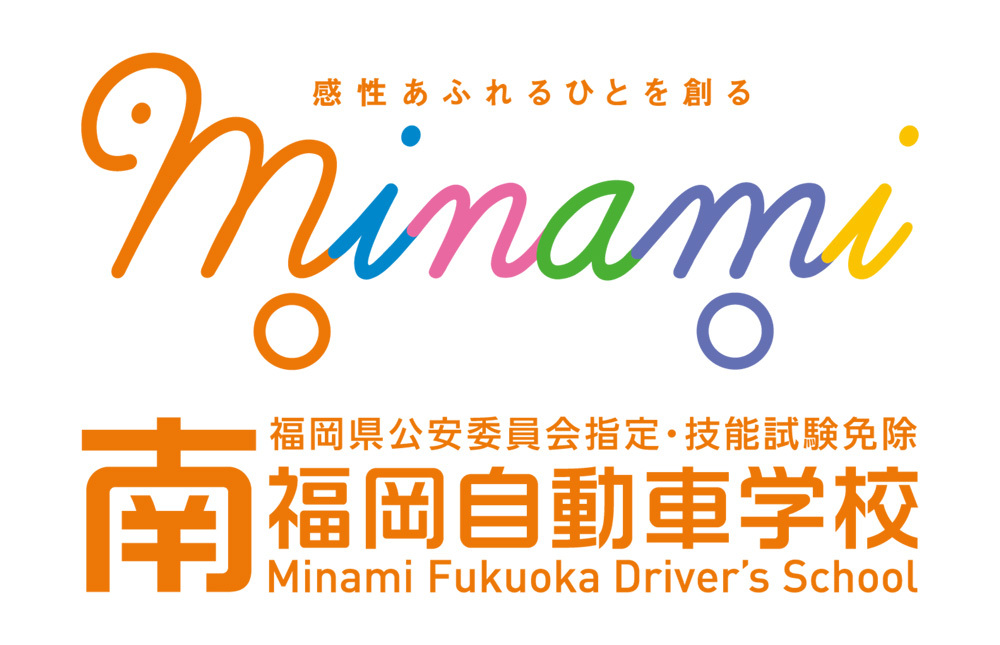
Minami Fukuoka Driving School's website is here.
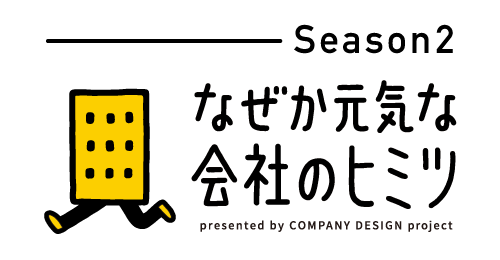
Season 2 of our series where Dentsu Inc.'s 'Company Design' team explores the secrets of 'vibrant companies' with originality. Episode 20 introduced Minami Holdings' challenge to transform the business model of a driving school that has been operating for over 60 years.
The Season 1 series can be found here.
The "Company Design" project site is here.
[Editor's Note]
Throughout the interview, President Egami consistently emphasized his belief in "the power of entertainment." Indeed, he himself became "Kame Rider," leading by example in practicing entertainment. This is where the editor's mischievous side emerged. Right at the very end, I asked this question: "I understand your belief in the power of entertainment. What I'd like to know is, how did you get those around you to believe in that power?"
In the advertising world, creativity is also said to be important. But demonstrating its value "quantitatively" is extremely difficult. President Egami's answer was very simple: "I don't know if it's quantitative, but perhaps it was about showing my resolve as president. When you show a resolve like 'I'm willing to go down with the company,' somehow, more people start supporting you."
The number of supporters. This, I realized, is a powerful metric for measuring entertainment and creativity "quantitatively." It's not about what percentage of people had a vaguely positive impression. What matters when persuading people is the concrete "number."
Was this article helpful?
Newsletter registration is here
We select and publish important news every day
For inquiries about this article
Back Numbers
Author

Makoto Kunio
Dentsu Kyushu Inc.
Business Production Bureau, Business Production Division 4 and New Business Development Office
Joined Dentsu Kyushu Inc. in 2017. After five years in the marketing department, currently in sales. Broadly involved in new business development, including co-producing programs with TV stations, developing products through industry-academia collaboration, and supporting startups.



